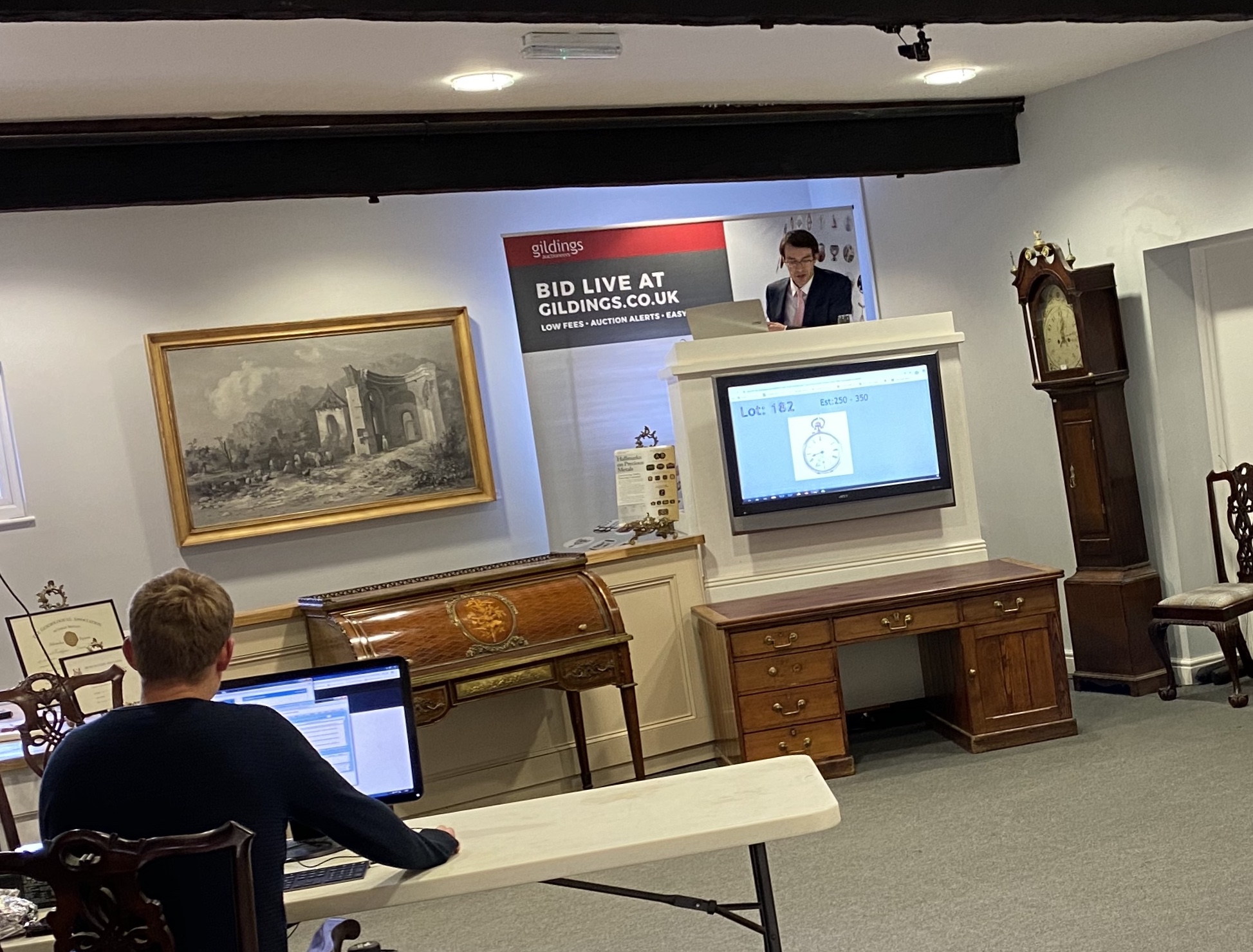How to bid in online auctions – the essential guide
 As more and more of us bid online we asked Mark Gilding, director of Leicestershire-based Gildings Auctioneers, for his tips on bagging a bargain in the ‘new normal’ of virtual auctions.
As more and more of us bid online we asked Mark Gilding, director of Leicestershire-based Gildings Auctioneers, for his tips on bagging a bargain in the ‘new normal’ of virtual auctions.
Bidding in Online Auctions
Has the lockdown marked a rise in bidding online?
Since auction houses introduced online bidding 15 years ago its steady growth became seismic in the light of the Covid-19 restrictions. Our first online-only auction saw an increase of 70 per cent in registered online bidders. This pattern has been repeated across UK auction houses reaching out to a younger demographic more used to online buying.
What is the process?
Bidders are required to register in advance; either on the website or via email. You will also need to register a bank card, but there should be no requirement to use this card to pay for any successful bid. Most auction houses also provide detailed instructions on their websites and offer assistance via telephone if there are any queries.
If bidding live online on sale day, you simply log in to your account and read and accept the terms and conditions. You can then click to watch the auction in a pop-up window and bid live. When the lot you are interested in is offered, you will see the increments displayed as bidding progresses.
How much does it cost?
 It’s important to investigate any additional fees that may apply to the hammer price, such as buyer’s premium charges, live bidding charges, or Artist’s Resale Right (ARR) charges. In recent times, the trade has been instructed to make these charges clearer for buyers, inclusive of VAT, so there are no nasty surprises when receiving an invoice.
It’s important to investigate any additional fees that may apply to the hammer price, such as buyer’s premium charges, live bidding charges, or Artist’s Resale Right (ARR) charges. In recent times, the trade has been instructed to make these charges clearer for buyers, inclusive of VAT, so there are no nasty surprises when receiving an invoice.
Buyer’s premium charges do differ among auctioneers. In fact, they may even vary within the same auction house if they are hosting different auction categories. For example, there may be one rate for a general auction and a higher rate for a ‘Fine’ auction; these rates also vary across the UK, ranging from 15 per cent (as at Gildings) to 30 per cent. VAT is also applicable unless the lot is exempt (such as with books and maps). This means that a stated buyer’s premium of 25 per cent is actually 30 per cent inclusive of VAT.
Live bidding charges may also apply; usually ranging between 3.6 per cent to 5.95 per cent per successful bid. At Gildings, our fee is 3.6 per cent and at the time of writing, along with many other auction houses, we are waiving this fee while restrictions make it impossible to attend a sale in person. This saving means that now is the perfect time to try online bidding.
What is ARR?
This is an additional charge that has been in place since 2012. It applies to original works of art created by any European artist who is still living or who has died within 70 years of the date of the sale. The artist (or their Estate), is entitled to claim the percentage fee of the hammer price. This fee is levied by the auctioneer and passed on to the relevant bodies to distribute to the artist.
ARR percentages are applied on a sliding scale, depending on the hammer price. Crucially, they only apply on works that sell for the minimum equivalent of €1,000 on the day of the auction (usually around £850) and can add a further 4 per cent to the hammer price for works realising between €1,000 to €50,000. Each auctioneer should have clear guidance on this, and lots where it is applicable should be clearly labelled.
How can I increase my chances of success?
As all collectors know, the odds of securing a coveted item are often hard to predict, but the following can increase your chances: • Getting your bid in early by offering the asking amount as bidding starts
- Deciding on a maximum amount and bidding without hesitation when the bidding starts to slow towards its conclusion
- Doing your research – watching auctions online is not just entertaining, familiarising yourself with the process will help you when you decide to take the plunge and bid for something yourself.
How do I know the item is of the expected quality?

While caution when it comes to buying an expensive or coveted item you haven’t seen in person is understandable, it’s important to remember that in the auction trade, reputation is everything. Over the past fifteen years, reputable auctioneers have worked hard to put processes in place to provide detailed and accurate condition reports for a global audience.
In the current situation where no visits are possible, this has become more important than ever. All reputable auction houses can be trusted to provide clear photography and accurate estimate prices, but if you require further information, do not hesitate to ask for a more detailed condition report, more photos or even a virtual inspection via video conferencing software.
Can I still bid in other ways?
Most auction houses who are hosting an online-only sale will probably still accept absentee and/or telephone bids as they would have done pre Covid-19.
What is absentee or commission bidding?
This is when you leave your maximum bid for the auctioneer to execute up to on your behalf. However, some buyers are reluctant to participate this way, especially if they are interested in an item at multiple times the pre-sale estimate. Ultimately, this requires an element of trust between bidder and auctioneer, as this ‘revealing of your hand’ has been abused in the past. Any reputable auctioneer should handle these with absolute integrity and conduct the bidding with transparency. At the end of the day, it is in the auctioneer’s interests to acquire items for buyers as cheaply as reserves and other bids allow, because it instils the trust that is crucial to building a strong relationship with buyers, who may also become vendors. As an auctioneer, the eyes of the world are now on you, and people will see through any attempt to exploit a strong bid left in good faith.
Explain telephone bidding?
This enables you to listen to the bidding and perhaps make a more impulsive or responsive bid. If leaving an absentee bid and your maximum bid is passed, obviously you miss out on the item. However, if you are a keen collector with flexible buying power, the telephone bid allows you to fight more competitively for the lot in the heat of battle. Telephone bidding rules do vary from house-to-house. Some have minimum limits as we do, others are beginning to charge for the service, so it’s advisable to do your research before opting for this route.
What if I am a seller, can I consign items online?
 Clearly, the ideal way to have items valued is by visiting an auction house or arranging a home visit for large or multiple items. While home visits are now resuming within social distancing guidelines, it still is not possible to visit for a valuation.
Clearly, the ideal way to have items valued is by visiting an auction house or arranging a home visit for large or multiple items. While home visits are now resuming within social distancing guidelines, it still is not possible to visit for a valuation.
However, pre Covid-19 most auctioneers already offered an online service for provisional valuations, which is good news for the many people who have been using lockdown to get round to sorting out items they would like to consign for auction. Usually this can be done by uploading images onto the auction house’s website, emailing photos, or arranging a video call.
You may be able to arrange for the safe and secure delivery of your item to the auction house, but even if not, lockdown presents a good opportunity to get the ball rolling on the process.
Will online sales decrease after the pandemic?
Every auctioneer is looking forward to the day when viewings can resume and they can look out across a packed saleroom. A room full of people adds to the atmosphere that auctioneers feed off and utilise to perhaps draw out an extra bid or two. Generating the same levels of excitement and engagement in online-only sales is a challenge for the auctioneer and needs to be approached in a different way.
By adapting interaction with the camera and enhancing engagement through digital channels, it’s possible to maintain the rhythm, flow and atmosphere so important at auction. The increase in online activity will undoubtedly change collectors’ behaviour as they widen the scope of their collecting and discover that, far from being a soulless experience, online bidding can be dramatic and exciting.
That said, most keen collectors will be as eager as the auctioneers to take a seat in the sale room again.
Mark Gilding has more than 25 years’ experience working at family-owned Gildings. He oversees all Gildings’ medals and militaria valuations and conducts most of the company’s home visits. For more information visit www.gildings.co.uk
Online auctions & Generation Z
 Online sales will lessen the alienation under 35s feel about buying antiques, writes Lydia Blundell
Online sales will lessen the alienation under 35s feel about buying antiques, writes Lydia Blundell
Covid-19 has closed the doors of auction houses throughout the country and swathes of highly anticipated fairs have been put off until the autumn or cancelled entirely. If establishments were underestimating the power of online platforms previously, they currently have no choice but to embrace them.
When I asked a group of 100 18-35 year olds if they thought the secondary market was as accessible for antiques as it was secondhand clothes, 74 per cent said ‘no’.
There is an entrenched face-to-face element when it comes to antiques, which younger people can find off-putting.
Natasha, who runs the online Urban Vintage Affair, said: “I understand how some people, who don’t know anything about antiques in particular, feel really intimidated going into a shop and not necessarily knowing what to look for and what to ask for.
“By buying online, you’re anonymous, and so someone can send a message or send an email asking questions and it doesn’t really matter. There’s no face-to-face contact, so you feel less intimidated asking questions that you may feel are a little stupid.”
The power of social media in the world of art and antiques cannot be underestimated: this has been confirmed by The Hiscox Report, which found that 75 per cent of those surveyed use Instagram to buy art.
Having beautiful stock is one thing, but reaching your audience is becoming more complex. It is possible that the circumstances brought about by a global pandemic will have a lasting effect upon how the world of art and antiques markets itself and communicates to its audience.
Lydia Blundell is a lifestyle and antiques blogger. Discover more at lydiasantiquelifestyle.wordpress.com


